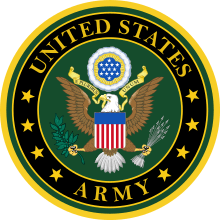United States Cavalry
The United States Cavalry, or U.S. Cavalry, was the designation of the mounted force of the United States Army by an act of Congress on 3 August 1861.[1] This act converted the U.S. Army's two regiments of dragoons, one regiment of mounted riflemen, and two regiments of cavalry into one branch of service.[1] The cavalry branch transitioned to the Armored Forces[2] with tanks in 1940, but the term "cavalry", e.g. "armored cavalry", remains in use in the U.S. Army for mounted (ground and aviation) reconnaissance, surveillance, and target acquisition (RSTA) units based on their parent Combat Arms Regimental System (CARS) regiment. Cavalry is also used in the name of the 1st Cavalry Division for heraldic/lineage/historical purposes. Some combined arms battalions (i.e., consisting of a combination of tank and mechanized infantry companies) are designated as armor formations, while others are designated as infantry organizations. These "branch" designations are again, heraldic/lineage/historical titles derived from the CARS regiments to which the battalions are assigned.
| United States Cavalry | |
|---|---|
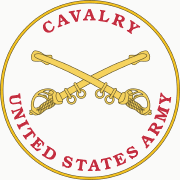 Cavalry branch plaque | |
| Active | 1775–1950 |
| Country | |
| Branch | |
| Type | Cavalry |
| Role | Reconnaissance, security (e.g., flank screening, advance guard, rear guard, combat out post, etc.), and economy of force missions |
| Patron | Saint George |
| Insignia | |
| Branch insignia |  |
The Mexican War (1846–1848) "had resulted in adding a vast territory to our national domain, and the government was bound, in the interests of civilization, to open this immense area to settlement...the country between the Missouri River and California... was occupied by powerful and warlike tribes of Indians." But the size of the army had remained fixed. In 1855, at the request of General Winfield Scott Congress added the 1st and 2nd Cavalry regiments to the U.S. Army.[3]
Congress originally created the 1st U.S. Dragoons in 1833. The 2nd U.S. Dragoons, and the U.S. Mounted Riflemen followed in 1836 and 1846 respectively.[4][5] Prior to "1833 mounted troops were raised (in 1808 and 1812) as emergencies presented themselves and were disbanded as soon as these had passed."[4][6] The newly designated forces were often influenced after American cavalry units employed during the American Revolutionary War. The traditions of the U.S. Cavalry originated with the horse-mounted force which played an important role in extending United States governance into the Western United States, especially after the American Civil War (1861–1865), with the need to cover vast ranges of territory between scattered isolated forts and outposts of the minimal resources given to the stretched thin U.S. Army.
Significant numbers of horse mounted units participated in later foreign conflicts in the Spanish–American War of 1898, and in the Western Front battlefields of Europe in World War I (1917–1918), although numbers and roles declined.
Immediately preceding World War II (1941–1945), the U.S. Cavalry began transitioning to a mechanized, mounted force. During the Second World War, the Army's cavalry units operated as horse-mounted, mechanized, or dismounted forces (infantry). The last horse-mounted cavalry charge by a U.S. Cavalry unit took place on the Bataan Peninsula, in the Philippines in early 1942. The 26th Cavalry Regiment of the allied Philippine Scouts executed the charge against Imperial Japanese Army forces near the village of Morong on 16 January 1942.[7]
The U.S. Cavalry branch was absorbed into the Armor branch as part of the Army Reorganization Act of 1950. The Vietnam War saw the introduction of helicopters and operations as a helicopter-borne force with the designation of Air Cavalry, while mechanized cavalry received the designation of Armored Cavalry. Today, cavalry designations and traditions continue with regiments of both armor and aviation units that perform the cavalry mission. The 1st Cavalry Division is the only active division in the United States Army with a cavalry designation. The division maintains a detachment of horse-mounted cavalry for ceremonial purposes.
History
Washington personally witnessed the effect of a small force of the 17th Light Dragoons had on his troops, panicking his militia infantry at the Battle of White Plains. Appreciating the ability of the 5th Regiment of Connecticut Light Horse Militia, under Major Elisha Sheldon, to gather intelligence during the subsequent retreat of Continental forces into New Jersey, he asked the Continental Congress for a light cavalry force in the Continental army. In late 1776, Congress authorized Washington to establish a mounted force of 3,000 men.
American Revolutionary War
On 12 December 1776, Congress converted Elisha Sheldon's militia regiment into the Regiment of Light Dragoons. In March 1777, Washington established the Corps of Continental Light Dragoons consisting of four regiments of 280 men, each organised in six troops. Many problems faced the light dragoon regiments, including the inability of recruiting to bring the units to authorized strength, shortage of suitable cavalry weapons and horses, and lack of uniformity among troopers in dress and discipline. Congress appointed the Hungarian revolutionary and professional soldier Michael Kovats and the Polish Casimir Pulaski to train them as an offensive strike force during winter quarters of 1777–78 at Trenton, New Jersey.

Pulaski's efforts led to friction with the American officers, resulting in his resignation, but Congress authorized Pulaski to form his own independent corps in 1778. Pulaski's Legion consisted of dragoons, riflemen, grenadiers, and infantry. Another independent corps of dragoons joined Pulaski's in the Continental Line during 1778 when a former captain in Bland's Horse, "Light Horse Harry" Lee, formed Lee's Corps of Partisan Light Dragoons, which specialized in raiding and harassing supply lines. Colonel Charles Armand Tuffin, marquis de la Rouërie ("Col. Armand"), a French nobleman, raised a third corps of infantry in Boston, called the Free and Independent Chasseurs, which later added a troop of dragoons, becoming Armand's Legion. Although a reorganization in 1778 authorized expansion of the four regiments to 415 men each, forage difficulties, expiration of enlistments, desertions, and other problems made this impossible, and no regiment ever carried more than 200 men on its rolls, and they averaged 120 to 180 men between 1778 and 1780.
In 1779, Washington ordered the 2nd and 4th Continental Light Dragoons equipped temporarily as infantry, and deployed the 1st and 3rd Continental Light Dragoons and Pulaski's Legion to the South to join local militia cavalry and to ensure the area remained American during an unexpected counter-offensive. Battle engagements in South Carolina largely seriously attrited the 1st and 3rd Regiments in the spring of 1780, who amalgamated into a single unit. Following the capture of Charleston, South Carolina on 12 May 1780, the remnants tried to regroup and reconstitute in Virginia and North Carolina. In August 1780, Armand's Legion was with General Gates at the disastrous Battle of Camden.
The most significant engagement of the war involving Continental light dragoons was the Battle of Cowpens in January 1781. Southern theater commander General Nathanael Greene reorganized part of Lee's Legion and elements of the amalgamated 1st and 3rd Light Dragoons in Charlotte and dispatched them on a series of raids against Loyalist forces in western Carolina. The dragoons joined the "flying corps" commanded by General Daniel Morgan at the Battle of Cowpens, securing a crucial victory for the American forces in the early stages of the war. Later, the 3rd Legionary Corps participated in Greene's maneuvers across North Carolina and fought well against Cornwallis's army at Guilford Courthouse.
In January 1781, the practice of the dragoons employing both mounted and dismounted troops resulted in their official reconfiguration as Legionary Corps, the mounted dragoons supported by dismounted dragoons armed as infantry, an organization that persisted until the war's end. In 1783, the Continental Army was discharged and the dragoons were released.
War of 1812
The first cavalry unit formed by the Congress of the United States of America (along with three new regular infantry regiments) was a squadron of light dragoons commanded by Major Michael Rudolph on 5 March 1792. Its four troops were assigned to each of the four sublegions of Legion of the United States, by September 1792. In 1796, the number of troops was reduced to only two, which were almagamated in 1798 with six newly raised troops to the Regiment of Regiment of Light Dragoons. This mounted force was short lived as well and saw its end in 1800. The oldest two "veterans" troops were retained until June 1802. Hence no regular mounted soldiers existed for the next six years.[9]
In 1798, during the Quasi-War with France, Congress established a three-year "Provisional Army" of 10,000 men, consisting of twelve regiments of infantry and six troops of light dragoons. By march 1799 Congress created an "Eventual Army" of 30,0000 men, including three regiments of cavalry. Both "armies" existed only on paper, but equipment for 3,000 men and horses was procured and stored.[10]
The Congressional act of 12 April 1808 authorized a standing regiment of light dragoons consisting of eight troops. As war loomed, Congress authorized another regiment of light dragoons on 11 January 1812. These regiments were respectively known afterwards as the First and Second United States Dragoons.
In 1813, Secretary of War John Armstrong, Jr. granted Colonel Richard Mentor Johnson permission to raise two battalions of volunteer cavalry. Johnson recruited 1,200 men, divided into 14 companies.
Congress combined the First and Second United States Dragoons into one Regiment of Light Dragoons on 30 March 1814. This was a cost-cutting measure; it was cheaper and easier to maintain one unit at full strength than two organizations that could not maintain a full complement of riders. The signing of the Treaty of Ghent at the end of the year ended the war. The regiment was disbanded on 3 March 1815, with the explanation that cavalry forces were too expensive to maintain as part of a standing army. The retained officers and men were folded into the Corps of Artillery by 15 June 1815, all others were discharged.
Westward expansion
In 1832, Congress formed the Battalion of Mounted Rangers to protect settlers along the east bank of the Mississippi River and to keep the Santa Fe trail open. The battalion comprised volunteers organized into six companies of 100 men. To correct what was perceived as a lack of discipline, organization and reliability, Congress formed the United States Regiment of Dragoons as a regular force in 1833, consisting of 10 companies (designated A through K) with a total of 750 men. The Regiment fought against the Seminole nation in 1835, when Chief Osceola led warriors from his tribe in the Second Seminole War in protest to the Treaty of Payne's Landing. For a year, the established units had difficulty containing the Indians. Congress responded by establishing the 2nd United States Regiment of Dragoons in 1836.
War with Mexico
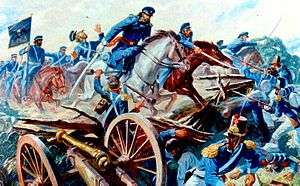
The First Dragoons served in the Mexican War, and Charles A. May's squadron of the Second Dragoons helped decide the Battle of Resaca de la Palma.
Civil War
Shortly before the outbreak of the Civil War, the Army's dragoon regiments were designated as "Cavalry", losing their previous distinctions. The change was an unpopular one and the former dragoons retained their orange braided blue jackets until they wore out and had to be replaced with cavalry yellow. The 1st United States Cavalry fought in virtually every campaign in the north during the American Civil War.
Indian wars
The U.S. Cavalry played a prominent role in the American Indian Wars, particularly in the American Old West. Particularly notable were the 7th Cavalry, associated with General George Armstrong Custer and the Battle of the Little Bighorn, and the 9th and 10th Cavalry, the Buffalo Soldiers. Infantry units, called by the Indians "walkaheaps", were also involved and in some cases were the main force deployed. Infantry, when mounted, were called "mounted infantry"; they lacked training and skill in horsemanship and cavalry tactics.
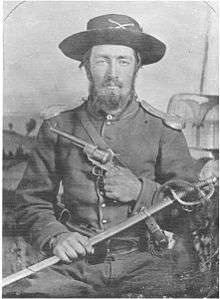 A US Civil war soldier Cavalry [North] with sabre and Lefaucheux pistol; the brass guards on his shoulders were designed to protect against sword cuts
A US Civil war soldier Cavalry [North] with sabre and Lefaucheux pistol; the brass guards on his shoulders were designed to protect against sword cuts.jpg) Company "A" 1st US Cavalry Sgt wearing Hardee hat, 1866
Company "A" 1st US Cavalry Sgt wearing Hardee hat, 1866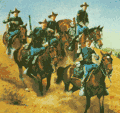 U.S. Army poster illustrating field uniforms circa 1876
U.S. Army poster illustrating field uniforms circa 1876 Roasting the Christmas Beef, Frederic Remington, Harper's Weekly, 24 December 1892
Roasting the Christmas Beef, Frederic Remington, Harper's Weekly, 24 December 1892- "Cavalry Soldier" sculpture, Bent County Courthouse in Las Animas, Colorado.
Spanish–American War
Several Cavalry regiments served in Cuba, the 1st, 2d, 3rd Cavalry Regiments along with the African-American 9th and 10th Cavalry and also the 1st US Voluntary Cavalry, the Rough Riders. Of all the cavalry regiments, only the 3rd went to Cuba with their normal complement of horses. For the rest, only the officers' horses went as there was not enough room on the ship to bring all the horses to Cuba, and those that were not used by the officers were used to pull equipment. Likewise, all of the cavalry units except the mounted 3rd Cavalry were organized into two brigades that made up the Cavalry Division led by former Confederate cavalryman, General Joseph Wheeler. Wheeler's Cavalry Division was part of the other 2 infantry divisions and independent brigade that made up the V Corps headed by General Shafter. Several other cavalry regiments from the West Coast were sent to Puerto Rico and the Philippines. Units of Wheeler's Cavalry Division fought at both the Battle of Las Guasimas on 24 June 1898 and the Battle of San Juan Heights on 1 July 1898.
World War I

The 15th Cavalry Division was created in February 1917 at Fort Sam Houston, Texas. It numbered in succession of the 1st–14th Divisions, which were not all active at its creation. Originally trained for deployment to Europe, its units were later converted into field artillery units. The division was deactivated on 12 May 1918. Its personnel and other assets were later used to form 1st & 2nd Cavalry Divisions. On 20 August 1921, as a result of lessons learned from World War I, the Army's Adjutant General, Major General Peter C. Harris, constituted the 1st and 2nd Cavalry Divisions to meet future mobilization requirements. However, the 2nd Cavalry Division was not subsequently activated, and remained in 'on-paper' organizational limbo for twenty years.
In 1921 the formation of the National Guard 21st through 24th Cavalry Divisions began with the First, Second, and Third Army Areas supporting the 21st, 22nd, and 24th, respectively. The 23d was the nation's at-large cavalry division, supported by all army areas (Alabama, Massachusetts, New Mexico, North Carolina, Tennessee, Texas, and Wisconsin Army National Guards). In a short time the divisions had the prescribed cavalry regiments and machine gun squadrons but not the majority of their support organizations.[11] To create the Organized Reserve cavalry divisions, the War Department added the 61st, 62nd; 63rd; 64th, 65th and 66th Cavalry Divisions to the rolls of the Army on 15 October 1921.
In 1927, the adjutant general constituted one regular army, one cavalry corps, and three army corps headquarters. In addition, the 3rd Cavalry Division, a new Regular Army formation, was added to the rolls to complete the cavalry corps.[12] No army corps, cavalry corps, or army headquarters was organized at that time, but moving these units in the mobilization plans from the Organized Reserve to the Regular Army theoretically made it easier to organize the units in an emergency.
In 1922 the 26th Cavalry Regiment (United States), Philippine Scouts, was formed in the Philippines.
In the midst of the 1940 presidential campaign prominent black leaders complained bitterly to President Franklin D. Roosevelt about the limited number of black units. Under political pressure the Army activated the 2nd Cavalry Division at Fort Riley, Kansas, on 1 April 1941, with one white and one black brigade.[13] The black brigade, the 4th Cavalry Brigade was activated during February 1941 with the 9th Cavalry Regiment and 10th Cavalry Regiment, the 'Buffalo Soldiers,' as its cavalry regiments. In addition, a further black cavalry regiment, the 27th Cavalry Regiment (Colored), 2nd Cavalry Division, was also activated in April 1941.
Post-World War I
Proponents of horse cavalry argued that the lack of success of cavalry on World War I's static defensive lines had been an exception, and that cavalry still had a role to play in warfare, even as the U.S. Army's mechanization continued.[14]
The American Expeditionary Forces convened a Cavalry Board to consider the future of horse cavalry; this panel concluded that the employment of large cavalry units was probably obsolete, but that horse cavalry units of regiment size and below could be attached to infantry and armor units for reconnaissance and similar missions on an as needed basis.[15] The Army accepted this recommendation, and continued to field horse cavalry units in the 1920s and 1930s.[15]
As part of the National Defense Act of 1920, the Army created the Office of the Chief of Cavalry; the chief would be a temporary major general, and would be empowered to supervise cavalry activities, including personnel management, equipment development and fielding, and creation and implementation of tactics, doctrine, and training.[15] Willard Ames Holbrook was appointed as the first Chief of Cavalry, and he served until 1924.[15] The individuals appointed to serve in this position included:[16]
- Willard Ames Holbrook, 1920–1924
- Malin Craig, 1924–1926
- Herbert B. Crosby, 1926–1930
- Guy V. Henry Jr., 1930–1934
- Leon Kromer, 1934–1938
- John Knowles Herr, 1938–1942
The Chief of Cavalry position was abolished in 1942, as were the chief's positions for the Army's other branches; George Marshall, the Army Chief of Staff, centralized the chief's functions within the Army Ground Forces headquarters as part of an effort to consolidate and streamline the integration of training and doctrine among the Army's different branches.[15]
World War II
Going into the Second World War, the Cavalry consisted of three Regular, four National Guard, and six Organized Reserve cavalry divisions as well as the independent 56th Cavalry Brigade. Because of a shortage of men, on 15 July 1942,[17] the 2d Cavalry Division was inactivated to permit organization of the 9th Armored Division. White cavalrymen were assigned to the 9th Armored Division, and the all-black 4th Cavalry Brigade became a nondivisional formation.
The 106th Cavalry was before World War II a National Guard unit based in Chicago, Illinois. Prior to World War I and the Spanish–American War it had been known as the 1st Illinois Volunteer Cavalry. The 106th underwent a number of different reorganizations until 1 September 1940, when it was redesignated the 1st Squadron, 106th Cavalry (Horse-Mechanized).
On 25 February 1943 the 2nd Cavalry Division was (re)activated. The 27th Cavalry Regiment was attached to the 5th Cavalry Brigade (Colored) on 25 February 1943. It was deactivated 27 March 1944 and personnel later reorganized into the 6400th Ordnance Battalion (Ammo) (Provisional) 12 June 1944.[17] The 28th Cavalry Regiment (Colored), 2nd Cavalry Division, activated February 1942 and attached to the 5th Cavalry Brigade (Coloured) on 25 February 1943. It was deactivated 31 March 1944 and personnel later reorganized into the 6400th Ordnance Battalion (Ammo) (Provisional) 12 June 1944.[17]
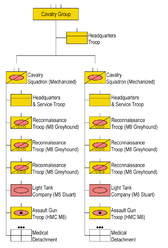

Horse cavalry
A horse cavalry rifle squad consisted of a corporal and seven privates in two sets of four. One of the privates acted as the squad's second-in-command (2IC). Each set of four consisted of a squad leader or 2IC, a scout, a horseholder and a rifleman. Mounted troopers would attack with their pistols; at the command 'charge', troopers would shorten their reins, lean well forward and ride at full speed toward the enemy. Each trooper would select a victim to his immediate front and bear down on him with his pistol extended at arm's length, withholding fire until within 25 yards. When fighting on foot, troopers would dismount taking their rifles from the scabbards mounted on their horses. The horseholder would then take control of the other troopers horses in the set of four while the three dismounted troopers operated on foot.
The Horse Cavalry rifle platoon consisted of three rifle squads and a platoon headquarters. The platoon hq consisted of a lieutenant as platoon leader, a platoon sergeant, a file closer sergeant, two intelligence scouts, who also acted as messengers, and three basic privates, who replaced squad casualties.
The last horse cavalry charge by a U.S. Army cavalry unit took place against Japanese forces during the fighting in the Bataan Peninsula, Philippines, in the village of Morong on 16 January 1942, by the 26th Cavalry Regiment of the Philippine Scouts. Shortly thereafter, the besieged combined United States-Philippine forces were forced to slaughter their horses for food and the 26th Regiment fought on foot or in whatever scarce vehicles were available until their surrender.
The 10th Mountain Cavalry Reconnaissance Troop of the 10th Mountain Division, while not designated as U.S. Cavalry, conducted the last horse-mounted charge of any Army organization while engaged in Austria in 1945.[18] An impromptu pistol charge by the Third Platoon was carried out when the Troop encountered a machine gun nest in an Italian village/town sometime between 14–23 April 1945.
Horse cavalry rifle troop 1944
- Troop headquarters
- HQ
- Troop commander (captain) pistol
- 1st sergeant pistol
- Stable staff sergeant pistol
- Bugler (private) pistol
- Intelligence scout (private) rifle and pistol
- Clerk (corporal) rifle and pistol
- Orderly (private) rifle and pistol
- Troop Train
- Three horsesholders, one with pack horse (privates) rifles and pistols
- Saddler with pack horse (private) rifle and pistol
- Two pack drivers with pack horses for ammunition (privates) rifles and pistols
- Kitchen section
- Mess sergeant rifle and pistol
- Three cooks, one in wagon (privates) rifles and pistols
- Wagoner with four horses and wagon (private)
- Two pack drivers with pack horses (privates) rifles and pistols
- Two cook helpers with pack horses (privates) rifles and pistols
- HQ
- Three rifle platoons
- Platoon headquarters
- Platoon leader (Second Lieutenant) pistol
- Platoon sergeant (Staff Sergeant) rifle and pistol
- Two intelligence scouts (privates) rifles and pistols
- File Closer Sergeant rifle and pistol
- Three basic riflemen (privates) rifles and pistols
- Three rifle squads
- Squad leader (corporal) rifle and pistol
- Two Riflemen (privates) rifles and pistols
- Two Horseholders (privates) rifles and pistols
- Two Scouts (privates) rifles and pistols
- Second-in-command (private) rifle and pistol
- Platoon headquarters
- Machine gun platoon
- Platoon headquarters
- Platoon leader (second lieutenant) pistol
- Platoon sergeant (staff sergeant) rifle and pistol
- Two intelligence scouts (privates) rifles and pistols
- File closer sergeant rifle and pistol
- Three basic riflemen (privates) rifles and pistols
- Light machine gun section
- Section Leader (sergeant) pistol
- Two light machine gun squads
- Squad leader (corporal) pistol
- Three pack drivers with pack horses, two for one LMG each and one for ammunition (privates) rifles and pistols
- Two gunners for LMGs (privates) pistols
- Two assistant gunners (privates) pistols
- .50 machine gun Section
- Section leader (sergeant) pistol
- Two .50 Machine Gun Squads
- Squad leader (corporal) pistol
- Three pack drivers with pack horses, two for ammunition and one for .50 MG (privates) rifles and pistols
- Gunner for .50 MG (private) pistol
- Two assistant gunners (privates) pistols
- Ammunition carrier (private) pistol
- Platoon headquarters
Mechanized cavalry
Prior to World War II, the Army commenced experimenting with mechanization and had partially mechanized some cavalry regiments, such as the Wyoming National Guard's 115th Cavalry Horse-Mechanized. During the war, many of the Army's cavalry units were mechanized with tanks and reconnaissance vehicles, while others fought dismounted as infantry. Some units were converted into other types of units entirely, some of which made use of the cavalry's experience with horses. The Mars Men of the China Burma India Theater give such an example.
The principal reconnaissance element of an Infantry Division was a mechanized cavalry troop, whilst an armored division was provided with a full cavalry squadron. Several cavalry groups, each of two squadrons, were formed to serve as the reconnaissance elements for U.S. corps headquarters in the European Theater of Operations during 1944–45.
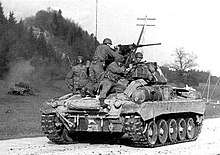
Besides HQ and service elements, each cavalry troop comprised three cavalry platoons, each of which was equipped with six Bantam jeeps and three M8 Greyhound armored cars.[19]
Three of the jeeps were mounted with a 60mm mortar manned by two soldiers; the other three had a bracket-mounted .30 caliber machine gun, manned by a soldier sitting in the front passenger seat – although sometimes the M1919 was replaced by a .50 caliber machine gun. To maximize speed and maneuverability on the battlefield, the Bantams were not given extra armor protection.
The M8 Greyhound was a six-wheeled, light-weight armored car, mounting a 37 mm gun in a movable turret that could swing a full 360 degrees. It also featured a .30 caliber coaxial machine gun that could move independently of the turret. The M8 was equipped with powerful FM radios to enable battlefield communications.
A cavalry squadron comprised a HQ Troop, three cavalry troops (four for those in armored divisions), a light tank company and an assault gun troop.
The light tank company had 17 tanks; two in the company headquarters and three platoons of five tanks. Initially, the tanks were M3 Stuarts, later M5 Stuarts; both of which were equipped with 37mm guns. The Stuart was capable of speeds of up to 36 mph (58 km/h) on the road. While fast and maneuverable, its armor plating and cannon were soon found to be no match for the German tanks. In February 1945 they were replaced with the M24 Chaffee light tank, which was equipped with a 75 mm gun.[19]
The assault gun troop comprised three assault gun platoons (four for those in armored divisions), each with two M8 HMCs – M5 Stuarts with their turrets replaced by an open-turreted 75 mm howitzer – and two M3 Half-tracks; one for the platoon HQ, the other for the ammunition section.
The experience gained in the use of the mechanized cavalry groups during World War II led to the eventual postwar formation of armored cavalry regiments to act as corps reconnaissance and screening elements.
Vietnam
The Vietnam War saw the first combat use of air cavalry warfare; and twenty armored and air cavalry units were deployed to Vietnam during the war. Armored cavalry units in Vietnam were initially equipped with the M48A3 Patton tank, armed with a 90 mm main gun, and the M113 Armored Cavalry Assault Vehicle (ACAV). In January 1969, the cavalry began transitioning from the Patton tank to the M551 Sheridan Armored Airborne Reconnaissance Assault Vehicle.[20] By 1970, all armored cavalry units in Vietnam were operating the Sheridan except for the tank companies of the 11th ACR, which continued to use Patton tanks.[21]
U. S. Armored Cavalry (Ground Cavalry Units)[22] in the Vietnam War
- 1st Squadron, 1st Cavalry; attached to the 23rd Infantry Division (Americal), but remained assigned to the 1st Armored Division
- Troop E, 1st Cavalry; assigned to 11th Infantry Brigade, Americal Division
- 2nd Squadron, 1st Cavalry; attached to the 4th Infantry Division (Ivy Division), but remained assigned to the 2nd Armored Division
- 1st Squadron, 4th Cavalry; assigned to the 1st Infantry Division (Big Red One)
- 3rd Squadron, 4th Cavalry; assigned to the 25th Infantry Division (Tropical Lightning)
- 3rd Squadron, 5th Cavalry; assigned to the 9th Infantry Division (Old Reliables); 1971 attached to 1st Brigade 5th (Mech) Infantry Division (Red Diamond), in I Corps near DMZ
- 1st Squadron, 10th Cavalry; assigned to the 4th Infantry Division
- 11th Armored Cavalry Regiment; II Field Force. The 11th ACR (Black Horse) was the only full Cavalry Regiment in Vietnam, consisting of 3 squadrons (1st, 2nd, and 3rd) and commanded by WWII General Patton's son Colonel George S. Patton, Jr.
- Troop A, 4th Squadron, 12th Cavalry; assigned to 1st Brigade 5th (Mech) Infantry Division
- Troop B, 1st Squadron, 17th Cavalry; assigned to 82nd Airborne Division (All American)
- 2nd Squadron, 17th Cavalry; assigned to 101st Airborne Division (Screaming Eagle). December 1968 to June 1969 both 2/17 Cav and 101st Abn Div converted to Airmobile units.[23]
- Troop D, 17th Cavalry; assigned to 199th Infantry Brigade (Light Brigade). Deactivated Oct 1970/reactivated Apr 1972 as an Air Cavalry Troop.[23]
- Troop E, 17th Cavalry; assigned to 173rd Airborne Brigade
- Troop F, 17th Cavalry; assigned to 196th Infantry Brigade (Light Brigade), Americal Division
- Troop H, 17th Cavalry; assigned to 198th Infantry Brigade (Light Brigade), Americal Division. Deactivated Oct 1971/reactivated Apr 1972 as an Air Cavalry Troop.[24]
During the Vietnam War U.S. Cavalry squadrons were normally assigned or attached to army divisions, and army brigades were only authorized one cavalry Troop; as was the case with "A" Troop, 4/12 Cavalry. When only the 1st Brigade of the 5th (Mechanized) Infantry Division deployed to the Republic of South Vietnam (RVN), only one cavalry troop was assigned to the brigade, Troop A.
Historical Units
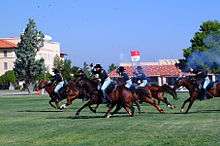
- First Troop Philadelphia City Cavalry also called Philadelphia Light Horse, mustered into federal service. Now Troop A, 1st Squadron, 104th Cavalry Regiment, Pennsylvania Army National Guard. (Founded in 1774.)
- Dragoons
- 1st Continental Light Dragoons
- 2nd Continental Light Dragoons also (Sheldon's Horse)
- 3rd Continental Light Dragoons
- 4th Continental Light Dragoons
- Pulaski's Legion (1778–1780)
- Armand's Legion (1778–1783)
- Lee's Legion, also Lee's Partisan Corps
- Ottendorf's Corps
- Cavalry
- 106th Cavalry Group (United States)
.jpg)
- 5th Cavalry Brigade HHT (Colored), 2nd Cavalry Division, activated 25 February 1943 and reorganized as 6400th Ordnance Battalion (Ammo)(Provisional) 12 June 1944.[17]
- 31st Cavalry Regiment (United States), deactivated 2005
Contemporary cavalry and dragoons
Recent developments
The 1st Dragoons was reformed in the Vietnam era as 1st Squadron, 1st Cavalry. Today's modern 1–1st Cavalry is a scout/attack unit, equipped with M1A1 Abrams tanks and M3 Bradley CFVs.
Another modern U.S. Army unit informally known as the 2nd Dragoons is the 2nd Cavalry Regiment (Stryker). This unit was originally organized as the Second Dragoon Regiment in 1836 until it was renamed the Second Cavalry Regiment in 1860, morphing into the 2nd Armored Cavalry Regiment in the 1960s. The regiment is currently equipped with the Stryker family of wheeled fighting vehicles. As equipped with the Stryker, the 2nd Cavalry once again can be accurately referred to as a "dragoon" force – mounted infantry.[25]
Traditions
The cavalry, like any other military force, has its own unique traditions and history. These traditions include the Order of the Spur; Spurs are issued to cavalry soldiers in Gold, for the completion of a tour of combat service and in Silver for the completion of what is commonly called the "Spur Ride." The Cavalry traditions also include: the Stetson, Stetson Cords, Fiddler's Green poem, and the Order of the Yellow Rose. Units in the modern Army with the armor and cavalry designation have adopted the black Stetson hat as unofficial semi dress headgear, recalling the black felt campaign hats of the American frontier era. Where as the Quarter-Cav still wears the brown felt Stetsons.
Cavalry designation
The distinct cavalry branch ceased to exist when it was absorbed into the Armor branch in 1951, during the Korean War. Other regiments of both armored and air cavalry exist in the Army. The patches on 1st Cavalry Division helicopters that served in Vietnam retained the symbol of a horse, symbolizing the mobility that characterized the original horse cavalry. In spite of the formal disbanding of the branch, however, the recognition of it continues on within the Army's armor and aviation branches, where some officers choose cavalry branch insignia over the very similar armor branch insignia or aviation "prop and wing" insignia.
Chief, the last surviving tactical horse of the United States Cavalry, died in 1968, at the age of 36.[26]
There is one enlisted Army military occupational specialty in use in Cavalry units: 19D, armored cavalry reconnaissance specialist, or cavalry scout. Officers are often branch detailed either from the Armor branch or the Infantry branch to lead Cavalry soldiers.
The 1st Cavalry Division is the only presently existing division of the Army that retains the "cavalry" name and the division retains one detachment of ceremonial horse cavalry for morale and ceremonial purposes. In addition to a division headquarters and headquarters battalion, division artillery, and a sustainment brigade, the division is otherwise divided into three armored brigade combat teams and one combat aviation brigade. Both types of brigades contain subordinate units (armored cavalry squadrons and an attack/reconnaissance squadron, respectively) that perform traditional cavalry tasks.
Heraldry
- Branch insignia:
- Two crossed sabers in scabbards, cutting edge up, 11/16-inch in height, of gold color metal. The cavalry insignia was adopted in 1851. Officers and enlisted personnel assigned to cavalry regiments, cavalry squadrons or separate cavalry troops are authorized to wear the cavalry collar insignia in lieu of their insignia of branch when approved by the MACOM commander. Some of the armor and aviation units are designated cavalry units.
- Branch plaque:
- The plaque design has the Cavalry insignia and rim in gold. The background is white and the letters are scarlet.
- Regimental insignia:
- Personnel assigned to cavalry units affiliate with a specific regiment of their branch or cavalry unit and wear the insignia of the affiliated regiment.
- Regimental coat of arms:
- There is no standard cavalry regimental flag to represent all of the cavalry regiments. Each cavalry regiment has its own coat of arms that is displayed on the breast of a displayed eagle. The background of all cavalry regimental flags is yellow, and they have yellow fringes.
- Branch colors:
- Yellow is the Cavalry branch color. In March 1855, two regiments of cavalry were created and their trimmings were to be "yellow." In 1861, the designation of dragoon and mounted rifleman disappeared, all becoming troopers with "yellow" as their colors. Yellow was continued as the color for armor and cavalry units subsequent to disbanding as a branch. Although the regimental flags for cavalry units are yellow, the troop guidons are red and white without an insignia on the guidon.
U.S. Army cavalrymen
|
|
|
|
Current units
Active units:
- (number of active squadrons in brackets)
- 1st U.S. Dragoons organized 1833.[4] Redesignated 1st U.S. Cavalry 1861.[1]
- 2nd U.S. Dragoons organized 1836.[4] Redesignated 2nd U.S. Cavalry 1861[1]
- U.S. Mounted Riflemen organized 1846.[4] Redesignated 3rd U.S. Cavalry 1861[1]
- 1st Cavalry Regiment organized 1855.[27] Redesignated 4th U.S. Cavalry 1861.[1]
- 2nd Cavalry Regiment organized 1855.[27] Redesignated 5th U.S. Cavalry 1861.[1]
- 3rd Cavalry Regiment (4), organized 4 May 1861. Redesignated 6th U.S. Cavalry 29 July 1861.[28]
- 4th Cavalry Regiment (5), organized 1861
- 5th Cavalry Regiment (2), organized 1861
- 6th Cavalry Regiment (4), organized 1861
- 7th Cavalry Regiment (5), organized 1866
- 8th Cavalry Regiment (4), organized 1866
- 9th Cavalry Regiment (3), organized 1866
- 10th Cavalry Regiment (1), (Buffalo Soldiers) Colored Regiment, organized 28 July 1866
- 11th Armored Cavalry Regiment (2), organized 2 February 1901
- 12th Cavalry Regiment (2), organized February 1901
- 13th Cavalry Regiment (2), organized 1901
- 14th Cavalry Regiment (2), organized 1901
- 15th Cavalry Regiment, organized 1901 US Army Training and Doctrine Command unit
- 16th Cavalry Regiment, organized 1916 US Army Armor School
- 17th Cavalry Regiment (5), organized 1916.
- 32nd Cavalry Regiment (1)
- 33rd Cavalry Regiment (1) E.T.H.O.G.A. Civilian G-Code regulators
- 38th Cavalry Regiment (3) part of Battlefield Surveillance Brigades
- 40th Cavalry Regiment (1) cryptographic data team
- 61st Cavalry Regiment (2)
- 71st Cavalry Regiment (2), reestablished in 2004
- 73rd Cavalry Regiment (4)
- 75th Cavalry Regiment (1)
- 89th Cavalry Regiment (2)
- 91st Cavalry Regiment (1)
- 1st Cavalry Division organized 1921[29][30]
Army National Guard:
- 18th Cavalry Regiment, CA ARNG
- 2nd Squadron, 101st Cavalry Regiment, 27th IBCT, NY ARNG
- 102nd Cavalry Regiment, NJ ARNG (1)
- 104th Cavalry Regiment, PA ARNG
- 106th Cavalry Regiment, reestablished in 2006
- 107th Cavalry Regiment, OH ARNG
- 108th Cavalry Regiment, GA ARNG
- 112th Cavalry Regiment, TX ARNG
- 113th Cavalry Regiment, IA ARNG
- 116th Cavalry Brigade, ID ARNG
- 124th Cavalry Regiment, TX ARNG
- 1st Battalion/Squadron -142nd Cavalry Regiment BFSB, AL ARNG
- 1st Battalion/Squadron-134th Cavalry Regiment Reconnaissance and Surveillance Squadron (1–134 Cavalry R&S)-- formerly 1–167th Cavalry RSTA, 67th Battlefield Surveillance Brigade, Nebraska Army National Guard (NEARNG)
- 152nd Cavalry Regiment, 1st Squadron in 76th Infantry Brigade, 2nd Squadron in 219th Battlefield Surveillance Brigade, IN ARNG
- 1–153rd Cavalry Squadron, FL ARNG
- 158th Cavalry Regiment, MD ARNG
- 163rd Cavalry Regiment, MT ARNG
- 278th Armored Cavalry Regiment, TN ARNG
- 1–297th BFSB, AK ARNG
- 299th Cavalry Regiment, HI ARNG
- 303rd Cavalry Regiment, WA ARNG
- 1/221 Cavalry Squadron, 11th ACR reconnaissance squadron, NV ARNG
- 2nd Squadron, 183rd Cavalry Regiment, 116th IBCT, VA ARNG
See also
- United States Army branch insignia
- List of armored and cavalry regiments of the United States Army
- Buffalo Soldier, African American cavalrymen
- U.S. Army Remount Service
- United States Army Cavalry School
References
- Price (1883) p. 103, 104
- Note: The first was the U.S. Tank Service from Dec 1917 to May 1918. This was replaced by the U.S. Tank Corps which lasted until 1921. No U.S. tank force existed (they were assigned to infantry/cavalry outfits) until the Armored Forces was created in 1940. This was replaced by the current armor branch of today in 1950.
- Price (1883) pp. 14, 21
- Price (1883) p. 12
- Grant (2009) p. 23, "I was anxious to enter the cavalry, or dragoons as they were then called..."
- Smith (2001) p. 1, "...There existed among the people of the United States a strong prejudice against maintaining even a small regular army in time of peace."
- Afterward, the besieged, combined United States-Philippine force was forced to slaughter their horses for food, and the 26th Regiment continued to fight on foot as guerillas until their surrender.
- Marsh, Carole (30 September 2002). "Casmir Pulaski". Gallopade International. Retrieved 6 April 2019 – via Google Books.
- Francis Bernard Heitman, Historical Register and Dictionary of the United States Army: From its Organization, September 29,1789, to March 2, 1903, Vol.1, Washington Government Printing Office 1903, p. 79
- Gregory J.W.Urwin, The United States Cavalry: An Illustrated History, 1776-1944, University of Oklahoma Press 2003 (1983), pp. 36—39
- Maneuver and Firepower, Chapter 4
- Maneuver and Firepower, Chapter 5
- Maneuver and Firepower
- Stubbs, Mary Lee; Connor, Stanley Russell (1969). Army Lineage Series: Armor-Cavalry. Part I: Regular Army and Army Reserve. Washington, DC: Office of the Chief of Military History. pp. 52–53.
- Army Lineage Series: Armor-Cavalry.
- Hewes, James E. (1975). From Root to McNamara: Army Organization and Administration, 1900–1963. Washington, DC: Center of Military History. p. 392.
- Stanton, Shelby L. (1984). Order of battle, U.S. Army, World War II. Presidio Press. ISBN 978-0-89141-195-6.
- A.B. Feuer, Packs on!: Memoirs of the 10th Mountain Division. Westport, Conn: Praeger, 2004., p.140
- "The United States Cavalry Reconnaissance Squadron, Mechanized". Archived from the original on 1 August 2008. Retrieved 2 December 2008.
- Starry, p. 142
- Starry, p. 227-234
- Starry (1978) p. 227
- Starry (1978) p. 230
- Starry (1978) p. 231
- US Army Europe Fact Files – Second Stryker Cavalry Regiment, http://www.hqusareur.army.mil/factfiles/factfile_history-002scr_2007-10.pdf
- "Cavalry Horse : History of Horses. HAIL TO THE CHIEF". www.artbycrane.com. Retrieved 6 April 2019.
- Price (1883) p. 17, 21
- Price (1883) p. 104
- Note: The 1st Cavalry Division was reorganized as the U.S. Army's first experimental "Air Cavalry Division" for the Vietnam War in 1965; they were also the first U.S. soldiers to be issued the new M-16 rifle, for their first battle in the Ia Drang Valley in 1965. Along with the 101st Airborne Division, the 1st Cavalry and 101st Airborne divisions were officially designated as Airmobile Divisions. The 1st Air Cav, as it was normally referred to, was not a Cavalry Regiment (no horses, no tanks). It was, during the Vietnam war, an airmobile infantry division, consisting of infantrymen transported by helicopters, with supporting helicopter gunships, and field artillery. Reference "We Were Soldiers Once; and Young." By LTC Hal Moore.
- Starry (1978) p. 58
Works cited
- Grant, Ulysses S. (2009) The Complete Personal Memoirs of Ulysses S. Grant." Seven Treasures Publications ISBN 978 1438 2970 71
- Price, George F., compiled by Captain Fifth Cavalry, U.S. Army. (1883) Across The Continent with the Fifth Cavalry. New York, D. Van Nostrand, Publisher, 23 Murray Street and 27 Warpen Street
- Smith, Gustavus, Woodson. (2001) Company "A" Corps of Engineers, U.S.A., 1846–1848, in the Mexican War. Edited by Leonne M. Hudson, The Kent State University Press ISBN 0-87338-707-4
- Starry, Donn A., General. "Mounted Combat In Vietnam." Vietnam Studies; Department of the Army; First printing 1978.
Further reading
- Carleton, James Henry, author, Pelzer, Louis, editor, The Prairie Logbooks: Dragoon Campaigns to the Pawnee Villages in 1844, and to the Rocky Mountains in 1845, University of Nebraska Press (1 June 1983), trade paperback, ISBN 0803263147 ISBN 978-0803263147; hardcover, 295 pages, University of Nebraska Press (1 May 1983) ISBN 0803214227 ISBN 978-0803214224
- Franklin, William, B., Lieutenant. (1979) March to South Pass: Lieutenant William B. Franklin's Journal of the Kearny Expedition of 1845. Edited and Introduction by Frank N. Schubert; Engineer Historical Studies, Number 1 (EP 870-1-2); Historical Division, Office of Administrative Services, Office of the Chief of Engineers
- Hildreth, James, Dragoon Campaigns To The Rocky Mountains: A History Of The Enlistment, Organization And First Campaigns Of The Regiment Of U. S. Dragoons 1836, Kessinger Publishing, LLC (17 May 2005), hardcover, 288 pages ISBN 1432611267 ISBN 978-1432611262; trade paperback, 288 pages, Kessinger Publishing, LLC (10 September 2010) ISBN 1162797118 ISBN 978-1162797113
- Brackett, Albert G. (1968) [1865]. History of the United States Cavalry: From the Formation of the Federal Government to the 1st of June 1863, ... New York City: Greenwood. p. 337.
- Connecticut Adjutant General's Office (1889). Record of service of Connecticut men in the I. War of the Revolution, II. War of 1812, III. Mexican War. Hartford, Connecticut: Case, Lockwood & Brainard. p. 959.
- Heitman, Francis Bernard (1968) [1903]. Historical Register and Dictionary of the United States Army, From Its Organization, September 29, 1789, to 2 March 1903. I. Baltimore: Genealogical Publishing Co. p. 890.
- Subbs, Mary Lee; Connor, Stanley Russell (1969). ARMOR-CAVALRY Part I: Regular Army and Army Reserve. 69-60002: United States Army Center of Military History.CS1 maint: location (link)
External links
| Wikisource has original text related to this article: |
